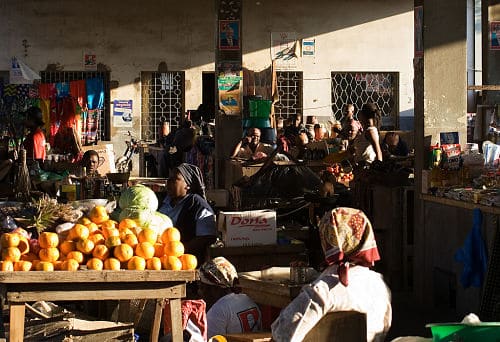Julie Archambault’s Mobile Secrets is an ethnographically vivid and distinctive contribution to the ever growing anthropological literature on the topic of youth in Africa. Whilst ethnographic accounts of the economic struggles of unemployed young men have become familiar tales of capitalism’s more recent, employment-less mutations in Africa (see Masquelier 2013; Mains 2012; though such issues are by no means skipped over by the author), Archambault productively chooses to focus her attention instead on the intimate lives of her interlocutors, exploring how growing inequality in Mozambique’s post-war era has transformed gender relations to the benefit of some and to the detriment of others. Although I do have a couple of concerns (which I shall touch on towards the end), Archambault’s book represents an achievement for a contemporary anthropology attuned to the detail of our interlocutors’ lives.

Anyone picking up Archambault’s book for the first time will not fail to notice the central role played by the mobile phone, and with good reason. Newer fieldworkers in Africa might perhaps fail to give mobile phones the attention they deserve as anything other than a commonplace. In peri-urban central Kenya where I work, for instance, the use of mobile phones and now smart-phone handsets (typically imported from China) are no longer out of the ordinary. Indeed, as Archambault herself deftly demonstrates in the case of Inhambane, they have become part of a new architecture of communication.
As we find out, in contexts like that of Liberdade where respectability and a general atmosphere of propriety ought to be upheld, the phone allows women users to transcend domestic boundaries.
Patriarchal authority in urbanising Africa has practically always found itself undermined by social change and although women now regularly participate in the labour market (Peterson 2004) moral norms that associate women with domesticity persist. With the assistance of the phone, married women and adult daughters are able to keep one foot in the domestic sphere of the homestead and yet simultaneously possess the potential to communicate beyond it, often with male suitors, regularly awakening male anxieties of infidelity in the process (104-116). Archambault’s perspective on the phone as something new, having more-or-less begun her fieldwork in 2006, is a welcome reminder that things were not ever thus, and that the use of phones warrant ethnographic attention, not least for their effects on social relationships. (It is also testament to the value of long-term ethnographic fieldwork as a vantage point on social change.)
The phone’s presence in many of the ethnographic anecdotes with which Archambault presents the reader serves to tie together the book’s wide-ranging themes (spanning petty crime, aspirations to wealth, redistributive practices, and notably the vagaries of romance in a highly unequal social setting). But it is also Archambault’s emphasis on the use of the mobile phone from which some of her grander claims about “truth” spring forth. It is the lives of women in Inhambane that regularly appear to have been most thoroughly transformed by the arrival of the mobile phone. With its assistance, young women have been able to conceal their liaisons with men, and in some cases, economically successful men who have played the role of providers, all the while maintaining a surface impression of propriety (saving face within their families, as well as without). That phones have been used by Liberdade residents to hide “ugly” truths whilst maintaining other, more palatable ones (150) prompts further reflection on the social effects of mobile phone handsets, and now their smart-phone reiterations. Archambault’s interest is in precisely how such technologies have assisted in creating alternative truths (or at least new ambiguities [152]) for her interlocutors. The author herself usually errs on the side of viewing such epistemological uncertainties as productive to her interlocutors: “certainty is a hope killer— it forecloses possibilities” (ibid.). What relevance these conclusions have for anthropologists studying the so-called “post-truth” world – where such uncertainties may be purposefully exploited by national governments to fundamentally disorder attempts by their opponents to criticise their actions – is an open question (Mair 2018), one that I believe Archambault has the ethnographic material to consider from a comparative perspective.

But if the phone is a ubiquitous presence throughout the book, it tends to play a supporting role to the most pertinent observations Archambault makes: those on the “intimate economy” (131) that emerges as a key theme towards the middle-of the book. It is across three chapters (entitled “Love and Deceit”, “Sex and Money”, and “Truth and Wilful Blindness”) where the gendered effects of the post-war economy reveal themselves (128). In “Sex and Money”, for instance, we find out how young women end up “trading on their subordinate status” (123), purposefully using sexual pretences to extract resources from richer men (127-8). This dynamic has created newfound difficulties for younger, aspiring though economically marginalised men who feel not only emasculated by the capacity of better-off providers (123), but equally threatened by the ostensibly “materialist” (124, used in scare quotes by the author to index this is a male discourse) pretensions of their wives and girlfriends. Poorer men still feel compelled to portray themselves as patrons – the main way “to feel like somebody (133) – even if they end up spreading their meagre resources hopelessly thin. Archambault is probably right to argue that the exchange of sex for money should not be framed in such transactional terms, and that “new and meaningful intimacies” (127) are bound to transpire from such unequal relationships, the dualism implicit in abstracting intimacy from exchange notwithstanding (and which is carefully avoided by the author, 132-3).
It is nonetheless striking to see women (albeit situationally) view their own motivations as somewhat “materialist”.
“I’m eating men’s money […] I charge them!”, one of her interlocutors forthrightly declares before quickly back-tracking in order to emphasise that her relationships were not so utilitarian.
At times I therefore found myself wishing that the topic of the intimate economy could have been the whole book rather than a substantial part. A section entitled “The Commodification of Intimacy and the Crisis of Authenticity” barely spans four pages despite appearing central to the themes Archambault introduces through her ethnography. A more sustained engagement with the burgeoning ethnographic literature and anthropological theory on money, commoditisation and gender was curtailed. Important ethnographic threads are also sidelined by the ranging ambitions of the book. “Young people found food for thought on intimacy in Brazilian telenovelas, Pentecostal sermons, NGO slogans, party politics, and everyday dealings with tourists and expatriates”, the author tells us, though this (hardly insignificant) list of knowledge producers and the reception of their ideas are never fully explored.

My other criticism relates to the manner of abstraction chosen by Archambault in an earlier chapter (named “Display and Disguise”) on what she calls “the politics of pretence”. Here we find that “all is not what it seems in a place where regimes of truth are constructed on a careful juggling of visibility and invisibility” (43). I felt that this language (bordering on the metaphysical) sometimes worked to romanticise much more mundane happenings, imbuing them with a meaning they perhaps did not possess in an immediate sense For instance, Archambault cites her research assistant’s caution over alerting other to their research activities as evidence of youth “creating remoteness” in order to make “claims of authorship over their lives” (69). My fieldworker’s instincts tell me that the reasons for such caution may be grounded less in the abstract logics of “creating remoteness” than a tendency (on the part of interlocutors) to avoid involvement in public disturbances, petty jealousies, not to mention the possible attention of the authorities. Though creating remoteness undoubtedly takes place, we lose a sense of what its purpose might be in a more grounded, socio-logical sense. After all, as Archambault herself remarks, Liberdade is a neighbourhood in which people live in close proximity and nothing much escapes comment in the circulation of gossip (55). Remoteness might not be an end in itself, nor a claim to authorship, rather than what I would argue is a more mundane social strategy on the part of interlocutors along the lines I mention above (for example, simply avoiding trouble). This is not to say that Archambault’s conclusions are in any way misguided but rather that I felt a step in the anthropological argument was missing – one that connected interlocutors’ motivations to their social consequences for interlocutors, rather than immediately finding their origin in more abstract cultural logics of display and disguise.
References
Mains, D. 2012. Hope is Cut: Youth, Unemployment and the Future in Urban Ethiopia. Philadelphia, PN: Temple University Press.
Mair, J. 2018. ‘Post-Truth Eras’. Anthropology of this Century 22. Available at: http://aotcpress.com/articles/posttruth-eras/
Masquelier, Adeline. 2013. ‘Teatime: Boredom and the Temporalities of Young Men in Niger’. Africa 83 (3): 470–91.
Peterson, D. 2001. ‘Wordy Women: Gender Trouble and the Oral Politics of the East African Revival in Northern Gikuyuland’. The Journal of African History 42: 469-489.
Archambault, Julie Soleil. 2017. Mobile Secrets: Youth, Intimacy and the Politics of Pretense in Mozambique. Chicago: University of Chicago Press. 224 pp. ISBN: 9780226447605
Featured photo by Senorhorst Jahnsen (flickr, CC BY 2.0)


